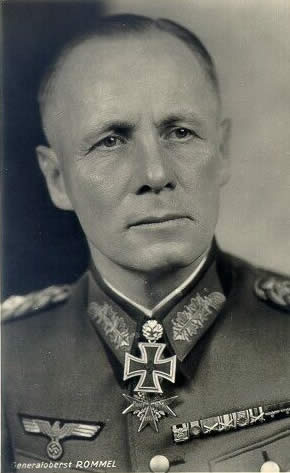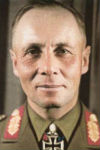The War in the Air
By Capt. Norman Macmillan, M.C., A.F.C.
The War Illustrated, Volume 8, No. 184, Page 124, July 7, 1944.
Throughout the twelve days' interval, between the break-out from the Anzio beach-head and the capture of Rome, aircraft of the No. 1 Tactical Air Force of the Mediterranean Allied Air Command scoured the roads leading to the battle area from enemy-occupied Italy to destroy enemy road communications. During the Allied attack against the German Army, Kesselring's supply problem became so acute that he was forced to use road transport by day, whereas formerly he had kept his road convoys hidden by day and moved them only at night. The fighter-bombers and medium-bombers sought their targets with pitiless efficiency. By night the roads were lit by parachute flares. Allied aircraft were flying over 3,000 sorties daily; 610 vehicles were destroyed and 561 damaged on May 26; on June 4 at least 1,200 German road vehicles were destroyed.
Close cover for the armies was give over the fighting zone. Before the break-out from the Anzio beach-head a Spitfire squadron moved in to operate from a landing strip one mile from the enemy advanced positions. Dumps and stores were guarded by the R.A.F. Regiment. The cover was continuous. On June 3, M.A.A.F. Flew 2,100 sorties and saw only one enemy aircraft in daylight. The German armies, almost isolated, were unable to withstand the drive of the Allied Armies. Rome was entered on June 4, 1944, and as the soldiers entering the city about 750 bombers of the M.A.A.F. were attacking railway targets on both sides of the French-Italian frontier. Kesselring's retreat was rapid, with aircraft pounding away at his flying columns pulling north into Tuscany.
June 4 was the seventeenth successive day of air attack on military targets in northern France. June 5 was to have been the day of assault against the Normandy coast, but adverse weather reports caused a postponement for 24 hours. The delay was not for flying weather, but for sea weather for the landing craft. This gave the air bombardment forces a further 24 hours for preparing the “softening” of the enemy-held zone. On June 5, up to 750 Fortresses and Liberators with about 500 escorting fighters attacked bridges, rail communications and radio towers. Mustangs bombed German army lorries. Thunderbolts bombed bridges, railway intersections and locomotives at Conflans, Gisors, Méziêres, Beauvais, and Mons; factories at Conflans and Juziers; and a radio station at Louviers.
By June 6, 25 railway and 9 road bridges had been destroyed, and only one railway and 5 road bridges were standing across the Seine between Paris and the sea; 16,000 sorties had been flown against 85 railway centres, and radio installations had been heavily attacked. Heavy bombers had attacked coastal targets by day and night.
From 11.30 p.m. on June 5 to sunrise on June 6, Bomber Command made ten attacks each with a hundred or more heavy bombers against German naval guns and land howitzers along the French coast bombing through ten-tenths cloud by pathfinder marker methods – the greatest single night attack on record, with over 5,000 tons of bombs dropped.
At 6 a.m. on the 6th day of the 6th month landings were made by surface forces on the Normandy beaches of the Cherbourg peninsula. Before dawn the biggest-ever airborne forces had already landed by parachute and glider, and jeeps, artillery, bombs, petrol, ammunition, rations followed by air; light tanks were flown in by Hamilcar gliders towed by Halifaxes. At dawn more than 1,000 U.S. heavy bombers supported by hundreds of medium and fighter bombers hammered the coast defences, roads, rail bridges and troop concentrations. More than 10,000 tons of bombs were dropped in 7,500 sorties in weather which compelled low flying. Never were there fewer than 200 fighters over the beaches.
Mr. Churchill stated that the Allied air force operating against the German army in this operation was over 11,000 aircraft, a world record force. R.E. Pioneers and R.A.F. Servicing Commandos landed with the first troops, and in three days Spitfires were flying from landing strips in Normandy. The bombing forces grew speadily larger day by day, even bombing areas where German snipers were secreted. Wounded began to be evacuated by air ambulances.
Strategic air power has been applied in recent weeks to reduce the enemy oil reserves. This strategy worked well against Rommel before the final victory in North Africa. Attacks have ranged far and wide over Europe, form Ploesti oilfields to synthetic oil plants in Germany, and storage tanks in Austria and Hungary. Berlin was bombed three nights running – June 9, 10, and 11 – by Mosquitoes with 4,000-lb. bombs, and on June 16 by Bomber Command's heavies. More than 1,000 Fortresses and Liberators screened by up to 1,000 Mustangs, Lightnings and Thunderbolts, bombed Berlin by day on June 21.
On June 13, Germany began bombing Southern England with pilotless bombers, p-planes for short. These weapons, constructed mainly in steel, are not radio-controlled, but directed by an automatic pilot, set before take-off. Here they differ from the radio-controlled glider bomb. P-planes are launched from concrete platforms heavily protected against bombing. Their take-off is assisted, probably by rocket accelerator. More will be known about launching methods following the inspection of platforms overrun by Allied forces in the Cherbourg peninsula, an area wherein were more than a quarter of the robot-planes' launching sites.
The present p-plane fuselage is 21-ft. 10-in long, with a maximum width of 31½ inches. Wing span is 16 ft. They are petrol driven and jet propelled by a reaction unit mounted above the aft end of the fuselage, and fly at between 300 and 350 m.p.h. Range is about 150 miles. A thrumming noise accompanies their flight. The exhaust shows as a glow and flash behind the tail; when this “light” goes out (i.e. when the engine stops) the p-plane dives and the synchronized explosion follows from five to fifteen seconds later.
The explosive, carried in a warhead rather like the marine torpedo charge – indeed, the p-plane is a real air torpedo, a hitherto much misused term – is contained in a thin casing in front of the fuselage, bringing the overall length up to 25-ft. 4½-in. The explosive power is equal to a German 1,000 kilogramme (one ton) bomb. Since their introduction these missiles have been used by day, but more by night. Targets claimed by the Germans to have been attacked include Greater London, Southampton and Portsmouth.
Since the p-plane attack began, in addition to continued counter-bombing of launching sites, Britain's anti-aircraft defences – guns and day and night fighters – have been organized to meet the new weapon, and many p-planes have been shot down into the sea or on open country.
Previous and next article from The War in the Air
The War in the Air
The air war continues to rise to greater intensity in every theatre of war, except perhaps the Russian, where an almost steady volume of air activity appears to be maintained, particularly by the Germ
Index
Previous article
I Was There! - We Carried Canadian Troops to the Beaches
How went the first hours of D-Day? In these personal stories glimpses are give of some of the actions and incidents that made June 6, 1944, memorable as the actual commencement of the greatest comb
Next article
Editor's Postscript
Like all celebrated military geniuses, Napoleon made some colossal mistakes. But he had so much practice in war and thought about it so constantly that he arrived very often at sound conclusions, ev





